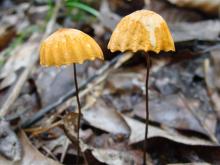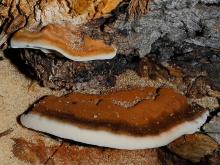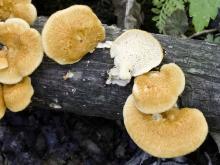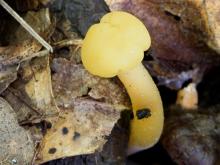Mushrooms
Media

Species Types
Scientific Name
Marasmius siccus
Description
The orange pinwheel marasmius is a tiny mushroom with an orange, bell-shaped, pleated cap, white gills, and a skinny brownish stalk. It grows scattered to many on dead leaves, wood, and twigs of deciduous trees.
Media

Species Types
Scientific Name
Sarcoscypha occidentalis
Description
The stalked scarlet cup is, indeed, a tiny red cup on a tiny white stalk. It grows scattered on fallen wet sticks and branches in damp deciduous woods.
Media

Species Types
Scientific Name
Ischnoderma resinosum
Description
The resinous polypore is a large, thick, velvety, brownish bracket fungus with a thick margin and whitish pores. It grows on logs and stumps of deciduous trees.
Media

Species Types
Scientific Name
Ganoderma sessile (formerly G. lucidum)
Description
The ling chih is a hard, usually flat, zoned bracket fungus with a reddish brown, shiny top. It grows at the base of living and dead deciduous trees, and also around stumps.
Media

Species Types
Scientific Name
Polyporus alveolaris (formerly Favolus alveolaris)
Description
This polypore is an orange to tan, fan-shaped bracket that is scaly on top; the underside has rows of white, six-sided, radially arranged pores. It grows singly or in groups on dead branches of deciduous trees.
Media

Species Types
Scientific Name
Phlebia incarnata (formerly Merulius incarnatus)
Description
The coral-pink merulius is a small, semicircular bracket fungus that is pinkish to coral to cream-colored, wrinkled, and veined beneath. It grows on dead logs and stumps of deciduous trees.
Media

Species Types
Scientific Name
Trichaptum biforme
Description
The violet toothed polypore is a bracket fungus with tough, hairy caps with violet margins and zones of white, brown, and black; beneath, the whitish violet pores break into teeth. It grows on stumps and logs of deciduous wood.
Media

Species Types
Scientific Name
Lenzites betulina
Description
Multicolor gill polypore is a bracket fungus with a semicircular, tough, hairy, multicolored, zoned cap; beneath, it's white, with leathery, gill-like tubes. It grows on dead deciduous wood.
Media

Species Types
Scientific Name
Leotia lubrica
Description
The jelly baby is a small mushroom with a gelatinous, orangish yellow stalk and head. It grows in groups on soil in mixed woods.
Media

Species Types
Scientific Name
Amanita spp. (about 600 species, worldwide)
Description
This large group of mushrooms accounts for 90 percent of mushroom-related deaths, so every mushroom hunter should be familiar with amanitas. They contain one of the deadliest poisons found in nature!
See Also



Media

Species Types
Scientific Name
Monotropa hypopitys
Description
Pinesap is a plant that puts the "wild" in wildflower! It lacks chlorophyll, so its roots connect to fungi underground and absorb nutrients from the fungi.
Media

Species Types
Scientific Name
Cladophora, Pithophora, and Spirogyra spp., and others
Description
Filamentous green algae forms green, cottony masses that are free-floating or attached to rocks, debris, or other plants.
Media

Species Types
Scientific Name
Monotropa uniflora
Description
Indian pipe lacks chlorophyll, so it is white, not green. Below ground, its roots join with fungi that connect to tree roots. This plant, then, takes nourishment indirectly from the trees.
About Mushrooms in Missouri
Mushrooms are a lot like plants, but they lack chlorophyll and have to take nutrients from other materials. Mushrooms are neither plants nor animals. They are in a different kingdom — the fungi. Fungi include the familiar mushroom-forming species, plus the yeasts, molds, smuts, and rusts.
Always be cautious when eating edible mushrooms. Be absolutely sure of the ID, and only eat a small amount the first time you try it to avoid a reaction..





















